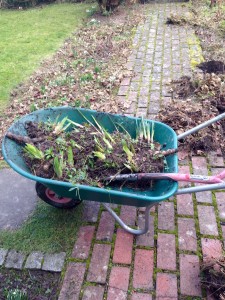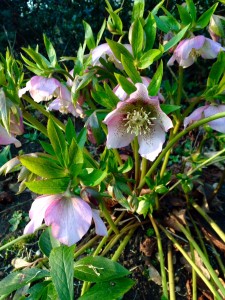
We are having some topsy-turvy weather of late. It’s cold one minute and heading for warmth the next, no wonder our plants are shooting and or flowering a little early… and as a result ever so slightly confused. They’ll be fine in the long run so no real worries at this stage. I would take care if we do have a significant frost as any new lush sappy shoots will be scorched. Prepare for this by using horticultural fleece … it really does work. And whatever you do don’t be tempted to put soft sappy plants outside if we are going to have an impending cold snap. Put them in your coolest place and be careful not to over water.
This aside it’s a great time to have a real clear up of any odd leaf piles and as I couldn’t do this last autumn, I’m going to be lifting up a border and replanting. The plants are mainly perennials that will tend to die down during winter and re-shoot in spring … so this is a perfect time. The remainder of the plants will be left alone and pruned at appropriate times throughout the year.
Have a plan if you’re going to lift up perennials. In most cases it may be as simple as lifting up with a fork, splitting and dividing, discarding old and diseased sections followed by replanting sections in the same place. For me, this gives me the opportunity to take all the perennials out and have a redesign of the area. What has worked well? Less well? Do I want to totally change and introduce new forms; although this could be costly!

It also gives me an opportunity to dig over the ground and incorporate some much needed well rotted organic matter. Digging doesn’t need to be at depth. If the soil is very friable and crumbly it is adequate to lay a good layer of compost on the soil surface – 10cm (4”) and then turn it in methodically over the entire area. If the ground has been more compacted it would be prudent to turn the soil over incorporating compost to the depth of a spade tine. Either way, it requires this to be done uniformly over the area; I’d even add horticultural grit or coarse sand if drainage needs to be improved.
Once the site has been prepared and the plants have been split and divided, this is an ideal time to place them where you think they would be best suited. Remember to note what the overall height was and the typical spread. Think about whether you want to create a border to be viewed more from the side. In this case it may be wise to think about graduated heights; tall at the back with shorter plants to the front. Personally, I like to jazz it up slightly by playing around with the depth of the border. Sometimes plants such as Alchemilla mollis (Lady’s Mantle) are great for planting at the front and through to the middle of the border. Plant some of your grasses nearer to the front to give some density to the bed and create pockets of interest. Check out this link to an online design training session it could be perfect to kick start you into action: http://www.bbc.co.uk/gardening/htbg2/virtual_garden/
Once planted water plants in to achieve good soil contact. If you are doing this now, wait until March to apply feed. There are lots of brands on the market such as Fish, Blood and Bone, Vitax Q4, Growmore. A good application rate is around 50g/ m² (1.8 ounces/ yd²). Follow this with a good thick layer of well rotted organic matter such as garden compost, mushroom compost or leaf mould at around 10cm (4”). This will assist in moisture retention and suppression of weeds. In time it will also contribute to soil fertility.
This is an exciting time of the year. Pop to your local garden centre or nursery for new plant forms and cultivars and ask them – they’re all very knowledgeable about their subject, and who knows you could have a completely different border this year.
Good luck and happy gardening!
For any gardening tips why not contact Tom Cole, Senior Horticultural Lecturer, Writtle College, Chelmsford, CM1 3RR by post (including a SAE) or by email at tom.cole@writtle.ac.uk








